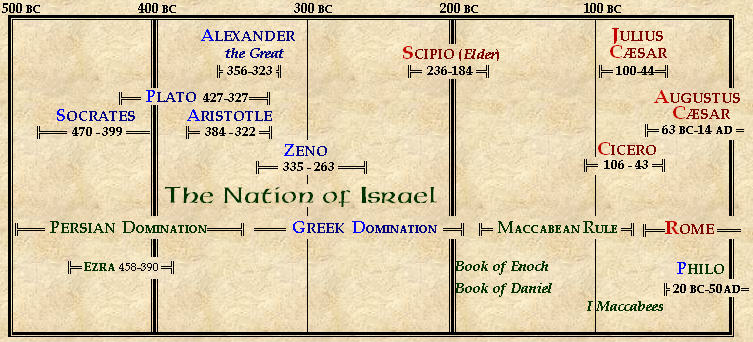|
|
Statue of Plato by Pisano; Siena, Duomo, (1280) |
|
|
Statue of Plato by Pisano; Siena, Duomo, (1280) |
 |
Theory of FORMS / IDEAS
Originally a way of understanding language; becomes a form of metaphysics
Distinction Between
NOUS
/ DIANOIA
Contemplative Faculty /
Reasoning Brain
NOESIS: Direct apprehension; intuitive comprehension
Aristotle: says of noesis that it is a participation in the object apprehended; subject-object relationship vanishes
Christians will later say PRAYER is an act of the NOUS: (not that prayer is act of INTELLECT in modern sense); rather an exercise of the contemplative faculty
DIANOESIS: Reasoning; sequential; used in Euclidean geometry
CONTEMPLATIVE LIFE
Highest Life for BOTH Plato and Aristotle
|
PLATO (427-347 BC), Greek philosopher. He was a pupil of Socrates. After Socrates execution (399), he left Athens. Some time after 388 he returned ans established a school on the outskirts of the city near the grove saced to Academus (hence the academy). Apart from one brief interlude, he seems to have spent the last 40 years of his life at the Academy. With the exception of a small collection of letters, Plato’s writings are in the form of Dialogues. Socrates if often the main speaker, with various critics or pupils, after whom the different dialogues are named, taking part in the discussion. |
|
In the earlier Dialogues the main emphasis is ethical. They insist that the cultivation of mind and will, “goodness of soul”, is the chief business of life; that this is attained by a rational insight into the nature of goodness, truth, and beauty; that morality and the claims of the enlightened conscience are to be respected in political life; and that the rational moral personality is created by the “recollection” of what the soul knows of these values. Since the soul naturally aims at what it believes to be good, wrongdoing is the pursuit of a falsely conceived good.
These doctrines are based on a metaphysic which is developed especially in the later Dialogues. This contrasts the world of sense and everyday experience with the true or higher world of `Ideas” (or better “Forms”). These “Forms” are “present to” individual entities, and by grasping the eternal Forms and participating in them the soul attains its true well-being and is lifted above the flux of “becoming”. But the highest value, the “Form of the Good” remains mysterious.
Plato”s main discussions of theology in the narrower sense are in the Timaeus and Book 10 of the Laws. The Timaeus describes how the divine Demiurge brings the world into being, how He makes it as an image of an eternal archetype, and how He enables it to share in His perfection by putting into it mind and soul. The Laws, Book 10, embodies the earliest known exposition of natural theology, namely a form of the cosmological argument based on the belief that all motions ultimately require at their head a “perfectly good soul”. It remains obscure how Plato related the highest of the Forms to God as the Supreme Soul. In the Timaeus the Forms are the thoughts of God, but, since God also created the universe after the pattern of the Forms, He would seem in some sense subordinate to them. It was, however, only among the more theologically interested Platonists of a later generation that the problem became a matter of debate.
(Adapted from E.A. Livingstone, Concise Dictionary of the Christian Church, Oxford, 2000, p. 455-456)
PLATONISM:
Plato’s doctrines had a wide following in the Hellenistic age and made an impact on later Judaism, evident in the Book of Wisdom and the writings of Philo (the chief representative of Middle Platonism). In the 3rd cent. AD a recasting of Plato’s system by Plotinus (Neoplatonism) was developed by Porphyry (c. 232-c.305) in conscious opposition to Christianity. Proclus (d.485) was the last head of th Academy and a celebrated commentator on Plato.
The beginnings of an interweaving of Platonism with Christian thought go back to Clement of Alexandria and Origen. More important for Christian theology was the influence of Platonic doctrines on St Augustine, whose authority did much to secure for many Platonic notions a permanent place in Latin Christianity. Henceforth the Platonic Forms were regularly interpreted as the creative thoughts of God. The relevance of Platonism for Christian mysticism was appreciated by Pseudo-Dionysius the Areopagite and other spiritual writers of both East. and West. The Renaissance led to a revival of interest in Plato himself, and Platonic influences have continued to play an important part in Christian philosophy, especially in England. On the Continent Protestant orthodoxy, with its distrust of natural reason, has commonly been hostile to Platonism and in the l6th cent. there was theological criticism of Greek metaphysics.
(Adapted from E.A. Livingstone, Concise Dictionary of the Christian Church, Oxford, 2000, p. 455)
This Webpage was created for a workshop held at Saint Andrew's Abbey, Valyermo, California in 1990